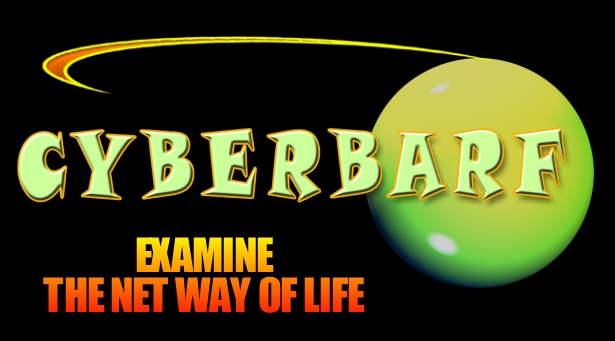cyberbarf
EXAMINE THE NET WAY OF LIFE
Vol. 5 No. 10
MAY, 2006
|
pindermedia.com presents IN THIS ISSUE: The Art of the Science of Animation iPod, Therefore iAm iToon on iPods Googlization Brain Splatter iToon on Inside Surprise THE NEW WORLD
MORE STRANGE BANNERS
|
 |
 |
 |
cyberbarf
EXAMINE THE NET WAY OF LIFE
The Art of the Science of Animation
Animation is 100 years old. One would think it would have to be older than a century. Both America and France claim the first animated film. The whole concept is to take individual still images and create action through the illusion of motion. As children, we were drawn into the primary colors of Saturday morning cartoons. This was the first source of animation consumption. Little did we know that only a few animation houses produced these shows. Little did we know that cartoons were mere filler in an earlier generation's Saturday theater film experiences. Little did we know that animation was the doorway to unlock an individual's imagination.
Bullwinkle. Tom and Jerry. The Roadrunner. Yogi Bear. The Jetsons. The Flintstones. Bugs Bunny. There were hundreds of other characters who shared the spotlight in the cartoon universe. Those characters marched from the studios into American television as a staple of children's programming. The animation mornings spurred the creation of commercial spokesmen and animated commercials, like Tony the Tiger and Capt'n Crunch, selling cereal. But the animated character was mostly left to the kid's table in the studio board room. It was never meant to be high art. It never fit into the classical film production sequence, where live actors and stunning sets were the key to a profitable project. Cartoons had no live actors, just voices for goofy 2D characters, grinding out keystone cop and old vaudeville jokes to America's first audiences of comedy, kids.
There has to be a hard wired function in the human brain that children like to draw things around them. Give a kid a crayon or marker, they will scribble something anywhere. Cavemen drew stories on cave walls. People hang on their walls paintings and pictures. Both represent the capture a moment in time on a physical plane. It helps the human mind remember something special.
Animation centers on drawing individual cels (frames). It usually takes 24 cels to make one second of film. In the old days of animation pioneers like Walt Disney, each cel was hand drawn and hand colored. This was a painstaking process which required dozens to hundreds of skilled artisans to create a single scene. For each cel, there needs a background, a foreground, a character position, expressions of emotion in a character, a partial sequence of movement (action), audio and background music to propel the story line to the next scene. A director needs to place all of these elements into tens of thousands of frames in order to get his or her vision of an animated feature into a final form.
Being prodded into this direction, I had to examine the current state of the field. Disney was the gold standard for animation in the world. Its studio artists have created a film library that was the envy of the creative community. Walt Disney was an artist who used his formal training and his quest for new uses in technology to create an animation and theme park factory. So specialized was the process of animation, Disney created its own school to train people on the skills to become part of the animation industry. The full length features of Disney were full screen masterpieces of light, action and music. They are so endearing that Disney titles from the 1960s and 1970s still sell well today. But the General audience nature of the projects led to some critics to classify Disney's work as being a just another form of children entertainment programming.
Doodles. Who did not doodle in your notebook during a boring portion of the school day? If you doodled on multiple pages, and flipped through them, you doodle would dance or move. The flip card is a simple form of animation. Making cartoons on a daily basis for fun can have one thinking about making those cartoon stills move. Making a stickman walk is a fairly easy thing to accomplish if there is no pressure from shareholders for another $100 million blockbuster. Just like public speaking is one of the number one fears of the average person, creating animation was a daunting task for any one who wanted to expand their creative talents.
In researching the topic, the current masters of animation had a few choice words for the newcomers. First, animation is still about the expression of art. Art is a personal expression. One has to master his or her own art, not merely attempt to copy another person's expression. Every person has their own style. Finding comfort in one's own style is the key to a rewarding experience. However, there are several significant influences. American animators still find inspiration from the early Disney animators. However, the next generation have become influenced by Japanese manga comics and films which have a different style in imagery and story telling. Pixar executives find continuing inspiration from the works of Hayao Miyazaki, the Walt Disney of Japan, even though a Pixar production does not look anything like a Miyazaki film.
Second, do not get carried away by the perceived ease of new computer technology. Computers have greatly increased the speed of repetitive tasks in creating animation sequences. But computers cannot substitute the central ideas of a story. Many people rely upon computers to solve technical issues. In an expressive medium such as art, a computer is merely a tool; a paint brush, a sculpture's wedge and hammer. Only the artist can use the tools to get to the end product. The tools cannot create art by themselves.
Third, do not rely upon technology. Animation is a creation of the soul. Animation creators are passionate about their projects because the project is part of them. The content must come from the artist. The story is the first element of the project. It is the most important thing. Without a good story, you will not have a good animation. If you do not see how you want your animation to appear before working on it, you can never tell your computer what do do to achieve that end.
Fourth, draw your own characters. Master the character's image. Master the character's expressions from all angles. Draw upon yourself and your observations to give your characters life. A good character should be familiar, but unique. Personality can be found in appearance, mannerisms, and speech.
Fifth, do not rush to sketch out story boards. A story board is the key frames of an animated feature. It usually is a crude drawing, with dialog and director's notes on how this frame sets the scene or tells an important event in the story. Just like any other means of expression, an animated feature is a story. Animators, like filmmakers, are story tellers. Completely write out a draft your story before attempting to create key frames. A story board is means of communicating to others your story ideas; it is not a substitute for the fully developed story.
Sixth, have your story and action sequences planned out before you start drawing cels (frames). This stops you from going off course and wasting valuable time. Animating anything is extremely time consuming. The major studios spend years on developing a single project. It takes hundreds of skilled technicians and artists to create an animated feature. Each segment of a single frame is taken a part, and dissected into individual skill sets (main drawing, background art, coloring, adding frames to create motion, frame checking, frame editing, etc.).
Seventh, find a comfortable method of assembly. Tying the sequences into a final finished product is a binding a self-printed manuscript. It takes skill and patience. There are a vast array of computer programs on the market which incorporate animation. There are 2D drawing programs. There are 3D model applications. There are hybrid animation studio software packages. The original method of animation was drawing, inking, coloring individual cels, then photographing each cel, then splicing each photocel into a final roll of film stock. Some animation studios still use the concept of “stop action” photography, taking a single image of scene (clay models for example), make minute adjustments, refilm, then continue until the sequence is finished. One now can create inside a computer world. Powerful programs can “tween” between key frames to fill in the action which would have taken studio artists hours to days to draw by hand.
Eighth, before starting - - - stop. Think before acting. Just as good writers are intense readers, good animators watch other animators work. Watch a Pixar film; rent a Miyazaki film; watch an evening of Nick or Cartoon Network. See how other professionals have met the challenge of their craft. See how these animators solved the basic story telling problems of character action and interaction. You will also learn that animation or cartoons are not just for kids.
The science of animation has taken off. George Lucas created Industrial Light & Magic to create CG effects for his own movies, then hired out his crews to work his magic in other projects. Pixar Studios revolutionized the computer animated feature by creating dynamic software to recreate fine details that hand drawn animators could never have been able to accomplish. All the other major film studios rushed to create CG departments. The G-rated family feature became the largest profit center in Hollywood. It has spawned a gold rush to find talent, to create the next Toy Story or Nemo franchise. Computer animation can easily create multiple profit centers like PC games, toys, character sponsorships, and sequels.
So in the past decade, there has been an industry explosion of new animation houses. Computer graphics technicians are in high demand. The reason is simple: most special effects have been computerized. Special effects have been incorporated into most of the movies, and most television commercials. Images have been turned into a commodity where techs can manipulate data in order to create movement, expression, and action over and over again in a wire frame window on a computer monitor. Watch a half hour of network television, and you will probably see at least a dozen computer animation techniques. (However, some techniques such as green screen backgrounds, touch-up actor lighting, or sound effects may be so good as to become seamless in the mind's eye.) Animation has become the mainstream.
But the massive flood of new works in theaters, DVDs, television channels and the Internet cannot drown out the simple fact that the advances of the science of animation has not lessen the need for the artistic side to remain strong. Other studios have made their own “clone” pictures of Pixar classics, but which little success to match the Pixar magic.
The world is getting hundreds of animation shorts, student films, independent features, new cartoon series and major studio films. The spectrum of modern animation appears to be endless.
So following the leads summarized from the topic research, I decided to do a simple animation. I used basic non-animation specific tools; a simple computer paint program and iMovie. The animation is a old basic gag concept. I drew each individual frame, old school. Then I worked into three segments: the fly, the action, and the reaction. I used iMovie to export the spliced frames into a QuickTime movie, in small web size. The final image quality is not great, but this is just a quick experiment (which took about two hours to complete).
This only validates that I have the patience to do something simple. With each new element, there are greater complex challenges to overcome. Studios have hundreds of skill specific specialists to master each element. Can a single person create something of high quality? Apparently. During my research, there was Japanese artist named Makato Shinkai who created his own film, by himself, on a Macintosh G4 computer. In any aspect of Life, when there is a will, there is a way.
iPod,
Therefore, iAm
If you can judge a book by its cover,
can you judge a person by his Playlist?
iPod,
Therefore, iAm
NEW T-SHIRT AT THE CYBERBARF STORE!
Don't forget to check out the
CYBERBARF BARF BAG podcast.
Googlization
The Go-Go-Gone 1990s have returned to the Stock Market in a somewhat limited fashion. But the back of the napkin business plan buzz is still the day trader's crystal meth high, growth stock envy coupled with low savings rates equal a mini-bubble for certain tech stocks. The triple digit price king is Google. The young billionaire founders are now multi-billionaires who are setting their sites on owning the world. Conquest, even in Napoleon terms, is a difficult to achieve plan. The company wants Google to be the source, resource and discourse for everything. The one-stop click for anything a net surfer would need, from information, links, research, news, video, library materials, photographs, socialization venues . . . the works. Just as on-line gamers have created a grand virtual world resting on magnetic medium on a server, Google would like to do the same in the real world on its server farm.
Every story needs a villain. In the computer world, the old Darth Vader character was Microsoft. The Redmond menace controlled the operating system, the brain behind the personal computer revolution. With Windows, Microsoft dominated the business world. Billions in free cash flow did not stop the adoption of more and more integrated features to strengthen the company's stronghold on OS. The integration of Internet Explorer into Windows was one of the main reasons Microsoft was targeted for anti-trust business practices. Explorer and Microsoft's market dominance led to other net browsers to fall into the pit of after-thoughts. Netscape, an early pioneer software application, was swept into the code trash heap. The battle cry was that Microsoft had to be stopped from taking over all aspects of the computing world. So Microsoft was dragged into court in the United States and European Union. Unbundling software and opening up source code were areas of contention. As the Microsoft antitrust saga begins to wind down, the press and government watch dogs will look for the next villain.
Google. Yahoo was the original search engine. Altavista was marketed as the business search portal. Then everyone began to add their own logos to the service. Ask Jeeves. Info.com. It was a cottage industry. Yahoo had the name presence in the market. It began publishing its own monthly magazine touting the top web sites. Yahoo was content on being the best search site on the web. Its ancillary endeavors were all related to increasing its advertising rates, but still centered on being a search engine. Google became a player when it began to manipulate the search engine results. Instead of relying upon banner ads on a search page for revenue, Google aggressively began to take sponsor dollars to move up a sponsor's link in the search pages. Google then sought affiliate partners to redirect traffic to sites for fees. Increased traffic equals increased net ad rates.
Then there was a rush to become not just a search page but to become a content provider. Google wants to take all the other net venture plans, like on-line book selling, on-line music downloads, on-line research intranets, and tie them into the Google system. The Google company philosophy is to take no prisoners. It wants to control all aspects of an Internet user's click life. But if you take any buzzword in the new Google business plan (music, books, research, information, directory services), you could substitute the word “advertising” to get the real meaning. Google still is an advertising company. With its stock price rising, it is printing billions of dollars worth of stock certificates embossed with In Google We Trust. Google will be buying its market share in these ancillary content ventures, but the real story will be when the rhetoric of “Googlization” of the World will lead to the company going under the Microsoft microscope.
iToon

Brain Splatter
Rumors are swirling around the concept of hijacking potential domain names by register services. People are familiar with the concept of cybersquatting, where a person registers a domain name that corresponds with a celebrity or major company, under the prospect of selling the valuable name back to the perceived owner. The Internet community has cleaned up that issue with specific registration contest rules to cut down on cybersquatting. But hijacking is a different concept. In theory, when anyone checks to see if a domain name is available, the search engine checks with all the domain registrar databases to see if there are any hits. During this inquiry directive, the unscrupulous registration service registers the inquiry domain as its own, with the prospect of selling it back to the interested party. This is clearly a conflict of interest. Registrars are supposed to be neutral.
Have you noticed an increase of “free” magazines arriving with your local post? Apparently, in order to maintain some minimum level of circulation (paid or unpaid), magazine publishers are sending free issues to businesses. Some of the free mags are tied with “affiliate” agreements with partners (code word: sponsors), tied to subscription discounts, or merely desperate attempts to boost readership. Newspaper circulation figures have been in free fall for the past two years. The demographic of under 30 does not read a newspaper. The chilling fact is that this same age group largely ignores news stories which is a serious negative to a stable democracy. If the young reader is not migrating to the Internet for news content, then the news publishing business is in more serious trouble than just lost circulation.
Censorship by government is a cancerous tumor inside a democratic nation. It can never be tolerated. Censorship by a business of its employees is a business decision that weighs the outrage of its customers versus potential litigation liability. Video that networks won't air can now be found on the Internet, being uploaded like music files a few years ago. There is a Wild Wild West mentality about being totally free and unfiltered with these broadcasts. The collision was highlighted in the last few weeks when the creators of Comedy Central's South Park were censored by their own network in a show about First Amendment freedom of speech through satire. There is an Anti-First Amendment trend growing in America. Apple Computer is claiming that Internet web sites are not traditional news organizations so they have no journalistic First Amendment freedom to report potential product developments (which Apple claims as trade secrets). There is no difference if the Wall Street Journal or a Mac fan site reports a potential new product. What is lost in the concept of our nation's founding fathers: that all journalism is citizen journalism.
iToon











